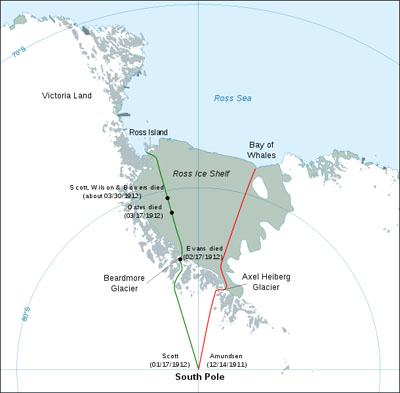Captain Robert Falcon Scott pictured with his team members after they reached the South Pole on 17 January 1912 before their ill-fated return journey home
Scientists and explorers all around the globe are today recalling the scientific achievements of the Antarctic explorer Robert Falcon Scott, as this day marks the centenary of Scott’s expedition party reaching the South Pole before they all tragically perished on their return journey home.
Known as the Terra Nova mission, Captain Scott led a party of five to reach the South Pole on 17 January 2012, but when they arrived at the Pole, they found out that they had been beaten to it by a Norwegian team, led by Roald Amundsen. He had also been a previous mission known as Discovery.
Turning back on 17 January 1912 for their 800-mile return journey back home, what followed was that Captain Scott and his four teammates tragically each perished due to exhaustion, starvation and the extreme cold of the Antarctic.
Scott is believed to have died on 29 March 1912, aged 42, on the Ross Ice Shelf in Antarctica.
The bodies of Scott and his colleagues – Edward Wilson, Henry Bowers, Lawrence Oates and Edgar Evans – were found in November 2012 by a search party. They also found some notebooks, diaries and letters describing key events during the ill-fated Terra Nova expedition.

Scott, depicted writing his journal in the Cape Evans hut during the winter of 2011
Scott’s final entry into his diary on 29 March 1912 was: “For God’s sake look after our people”.
He also left a public message: “We took risks, we knew we took them; things have come out against us, and therefore we have no cause for complaint, but bow to the will of Providence, determined still to do our best to the last … Had we lived, I should have had a tale to tell of the hardihood, endurance, and courage of my companions which would have stirred the heart of every Englishman. These rough notes and our dead bodies must tell the tale, but surely, surely, a great rich country like ours will see that those who are dependent on us are properly provided for.”
In January 1913, before the Terra Nova ship left for home, the ship’s carpenters made a large wooden cross. They inscribed the cross with the names of Scott’s party and a line from Alfred Lord Tennyson’s poem Ulysses: “To strive, to seek, to find, and not to yield.”
Scott’s scientific legacy

Routes to the Antarctic during the Terra Nova 1911-1912 expedition
But despite not being the first to reach the Antarctic, Scott’s mission led to important scientific discoveries. For instance Scott discovered 400 new animal species while in Antarctica, as well as paving the way for geographical understanding and biodiversity.
Scott’s son, Sir Peter Scott, went on to become one of the founders of the World Wildlife Foundation (WWF) and the he International Union for Conservation of Nature (IUCN).
Today, Scott’s grandson Falcon Scott will commemorate his grandfather’s legacy at Scott Base in the Antarctica. Scott, a builder, is in the Antarctic for five weeks to help preserve the hut that his grandfather used as a base during his Terra Nova expedition to the Antarctic.